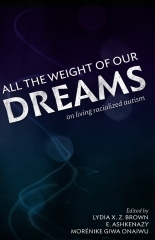What do you think?
Rate this book


500 pages, Paperback
First published June 19, 2017
Autism is many things. But it is seldom what it is perceived by people to be. It isn’t a tragedy. It isn’t a ravaged life. It isn’t an entity that destroys lives. It isn’t a disease.
- Morenike Giwa Onaiwu
I accepted his implicit judgment that the ability to act abled meant that one was not really disabled. And that is the unfortunate consequence for those who are good enough at acting abled. Once people think of you as abled any time you are unable to keep up the act is seen as something to be suspicious of.
- Amanda Filteau
"I had 'the talk' with my kids this morning in the car. Not the 'birds and the bees' talk. The 'how to stay alive because you're black and therefore a threat' talk.
- Morenike Giwa Onaiwu
"Somebody I have to work with to survive will respect at most two of the three things that are most central to who I am: my race, my gender or my neurodivergence."
- kiran foster
"This is also why I am frustrated and disappointed when disability activists speak about racism as though it's over, or dismiss racism as irrelevant to ableism, as well as when organizers for racial justice are completely ignorant to disability issues, or dismiss ableism as simply no-existent or unconnected to racial oppression and white supremacy."
- Lydia X Z Brown
"On every page, in every account, from every contributor, you will find one profound, universal theme threaded silently and artfully throughout the entire anthology. Again and again, you will find that the answer to the aforementioned question, now unspoken, 'What does autism have to do with race?' is a gentle, but resounding, 'Everything.'"
- Morenike Giwa Onaiwu